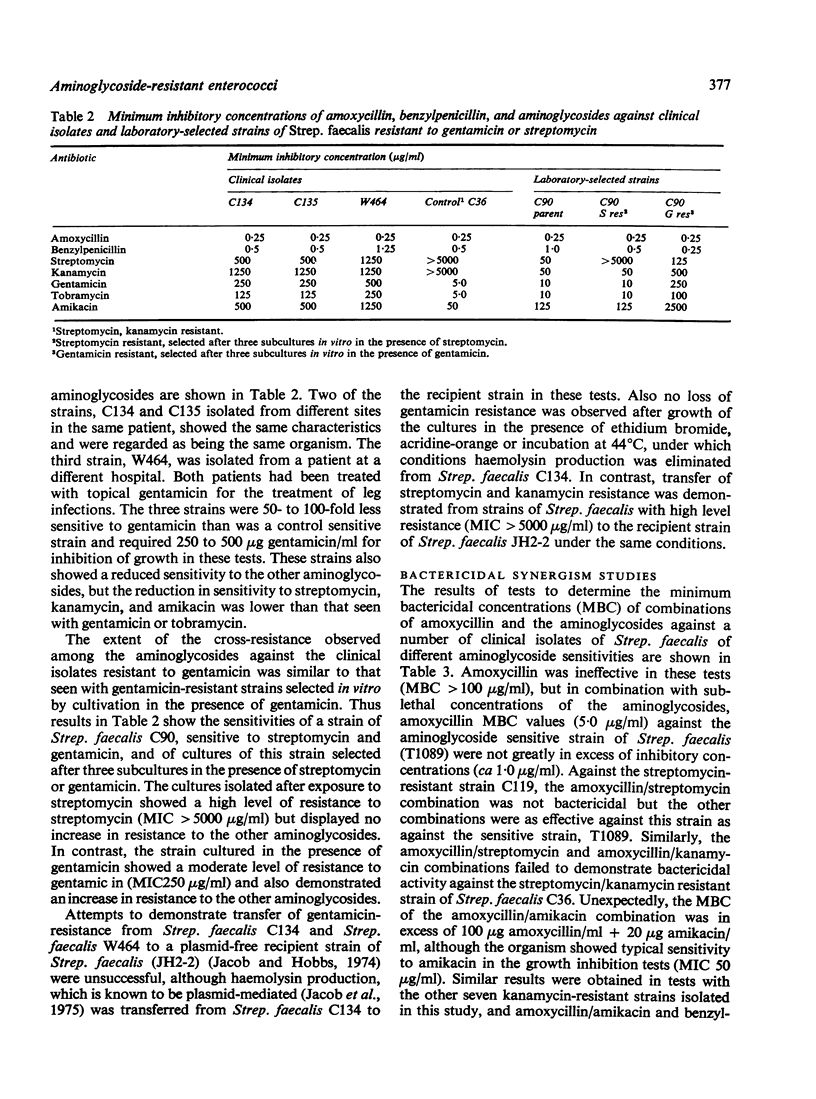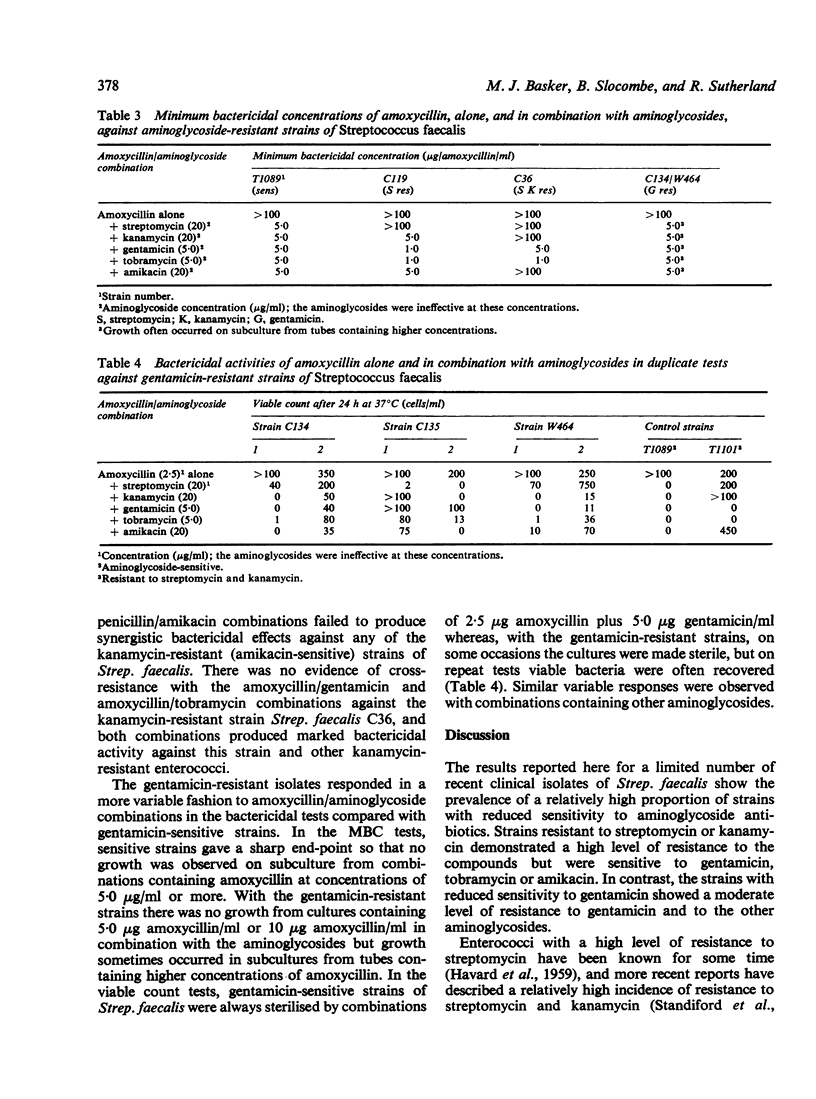Abstract
Thirty-four recent clinical isolates of Streptococcus faecalis were tested for sensitivity to amoxycillin, benzylpenicillin, streptomycin, kanamycin, gentamicin, tobramycin, and amikacin. Amoxycillin was two- to four-fold more active than benzylpenicillin and all strains were inhibited by low concentrations of the penicillins. The aminoglycosides were less active against the enterococci than were the penicillins and a significant number of strains were insensitive or relatively insensitive to one or more of the aminoglycosides. Thus, eight (23%) strains showed a high level of resistance to streptomycin and kanamycin (MIC greater 5000 microng/ml) but were sensitive to gentamicin, tobramycin, and amikacin. In addition, two strains of Strep. faecalis, isolated at different hospitals from patients who had received topical gentamicin therapy, were relatively resistant to gentamicin (MIC250 to 500 microng/ml) and were less sensitive also to the other aminoglycosides. Bactericidal synergy was demonstrated by amoxycillin/aminoglycoside combinations against the enterococci, provided that the test strain of Strep. faecalis was sensitive to the aminoglycoside in the combination. An exception to this was the combination of amoxycillin plus amikacin which was not synergistic against kanamycin-resistant strains of Strep. faecalis although these organisms were sensitive to amikacin in the growth inhibition tests. The gentamicin-resistant strains showed variable responses to amoxycillin/aminoglycoside combinations in tests for bactericidal synergy and were generally less sensitive than typical strains of Strep. faecalis.
Full text
PDF





Selected References
These references are in PubMed. This may not be the complete list of references from this article.
- DEIBEL R. H. THE GROUP D STREPTOCOCCI. Bacteriol Rev. 1964 Sep;28:330–366. doi: 10.1128/br.28.3.330-366.1964. [DOI] [PMC free article] [PubMed] [Google Scholar]
- HAVARD C. W., GARROD L. P., WATERWORTH P. M. Deaf or dead? A case of subacute bacterial endocarditis treated with penicillin and neomycin. Br Med J. 1959 Mar 14;1(5123):688–689. doi: 10.1136/bmj.1.5123.688. [DOI] [PMC free article] [PubMed] [Google Scholar]
- Holmes R. K., Minshew B. H., Gould I. K., Sanford J. P. Resistance of Pseudomonas aeruginosa to gentamicin and related aminoglycoside antibiotics. Antimicrob Agents Chemother. 1974 Sep;6(3):253–262. doi: 10.1128/aac.6.3.253. [DOI] [PMC free article] [PubMed] [Google Scholar]
- Iannini P. B., Ehret J., Eickhoff T. C. Effects of ampicillin-amikacin and ampicillin-rifampin on enterococci. Antimicrob Agents Chemother. 1976 Mar;9(3):448–451. doi: 10.1128/aac.9.3.448. [DOI] [PMC free article] [PubMed] [Google Scholar]
- Jacob A. E., Douglas G. J., Hobbs S. J. Self-transferable plasmids determining the hemolysin and bacteriocin of Streptococcus faecalis var. zymogenes. J Bacteriol. 1975 Mar;121(3):863–872. doi: 10.1128/jb.121.3.863-872.1975. [DOI] [PMC free article] [PubMed] [Google Scholar]
- Jacob A. E., Hobbs S. J. Conjugal transfer of plasmid-borne multiple antibiotic resistance in Streptococcus faecalis var. zymogenes. J Bacteriol. 1974 Feb;117(2):360–372. doi: 10.1128/jb.117.2.360-372.1974. [DOI] [PMC free article] [PubMed] [Google Scholar]
- Moellering R. C., Jr, Wennersten C., Weinstein A. J. Penicillin-tobramycin synergism against enterococci: a comparison with penicillin and gentamicin. Antimicrob Agents Chemother. 1973 Apr;3(4):526–529. doi: 10.1128/aac.3.4.526. [DOI] [PMC free article] [PubMed] [Google Scholar]
- Porthouse A., Brown D. F., Smith R. G., Rogers T. Gentamicin resistance in Staphylococcus aureus. Lancet. 1976 Jan 3;1(7949):20–21. doi: 10.1016/s0140-6736(76)92912-3. [DOI] [PubMed] [Google Scholar]
- Ruhen R. W., Darrell J. H. Antibiotic synergism against group D streptococci in the treatment of endocarditis. Med J Aust. 1973 Jul 21;2(3):114–116. doi: 10.5694/j.1326-5377.1973.tb128693.x. [DOI] [PubMed] [Google Scholar]
- Russell E. J., Sutherland R. Activity of amoxycillin against enterococci and synergism with aminoglycoside antibiotics. J Med Microbiol. 1975 Feb;8(1):1–10. doi: 10.1099/00222615-8-1-1. [DOI] [PubMed] [Google Scholar]
- SUTHERLAND R., ROLINSON G. N. ACTIVITY OF AMPICILLIN IN VITRO COMPARED WITH OTHER ANTIBIOTICS. J Clin Pathol. 1964 Jul;17:461–465. doi: 10.1136/jcp.17.4.461. [DOI] [PMC free article] [PubMed] [Google Scholar]
- Standiford H. D., De Maine J. B., Kirby W. M. Antibiotic synergism of enterococci. Relation to inhibitory concentrations. Arch Intern Med. 1970 Aug;126(2):255–259. [PubMed] [Google Scholar]
- Warren R. E., Roberts S. O. Letter: Gentamicin-resistant Staphylococci. Lancet. 1976 Mar 6;1(7958):543–544. doi: 10.1016/s0140-6736(76)90336-6. [DOI] [PubMed] [Google Scholar]


